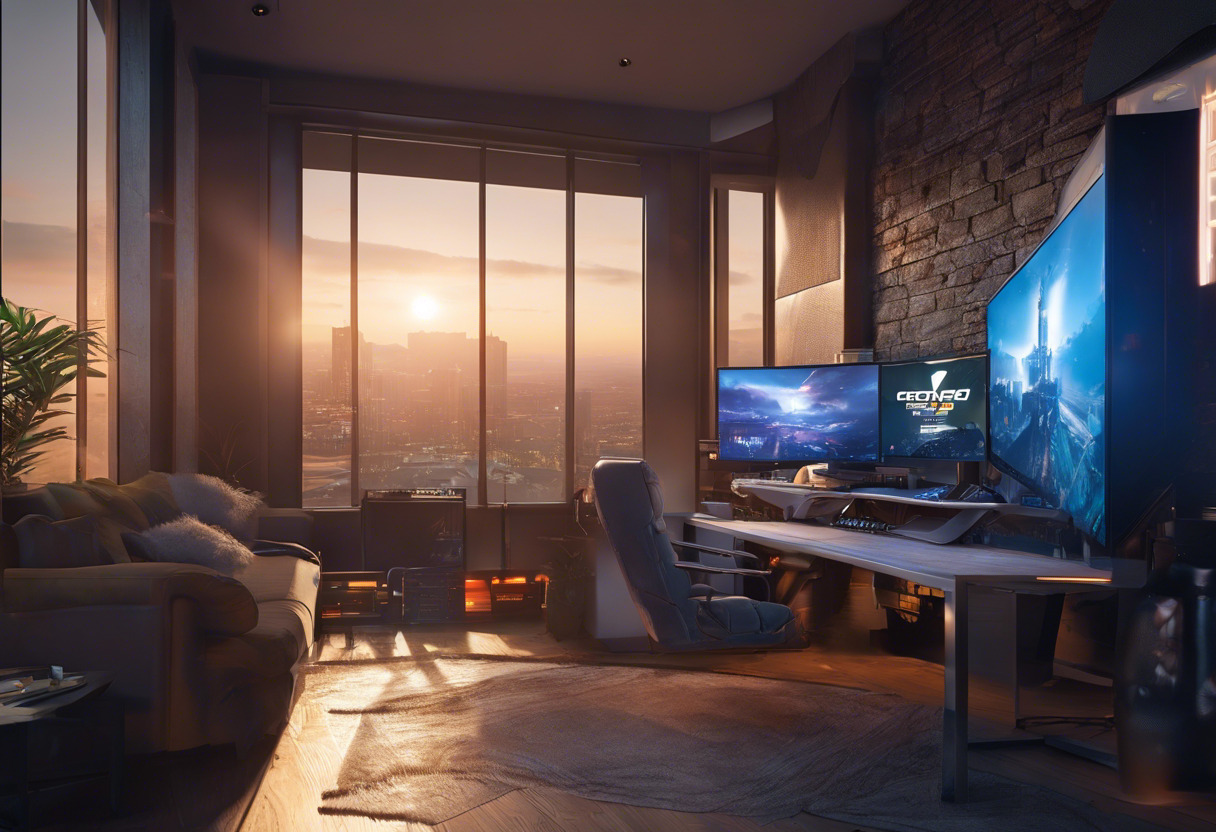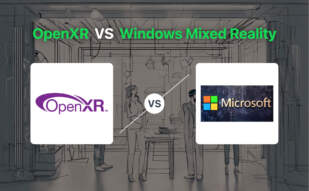Considering OpenXR vs Unity, Unity serves as a robust game engine for 2D, 3D, and AR/VR games while OpenXR shines as an open, royalty-free standard that solves AR/VR fragmentation and fosters cross-platform compatibility. Opt for Unity for game creation, however, for seamless compatibility on numerous devices, harnessing OpenXR is a wiser choice.

Key Differences Between OpenXR and Unity
- Functionality: OpenXR exists to unify AR/VR software development while Unity is a game engine supporting 2D, 3D, and AR/VR game creation.
- Language: Unity offers multiple coding languages, including BOO script, JavaScript, and C#, whereas OpenXR is an API helping developers in targeting VR/AR hardware.
- Cost: Unity’s pricing model involves a fee per game installation, posing a potential drawback for developers, whereas OpenXR is a royalty-free, open-source standard.
- Portability: OpenXR shines for its cross-platform functionality reducing code porting or rewriting, while Unity’s cross-platform capabilities are specific to game launching.
| Comparison | OpenXR | Unity |
|---|---|---|
| Initial Release | July 29, 2019 | 2005 |
| Scope | API for AR/VR | Game Development Engine |
| Platform Compatibility | Multi-platform, including Microsoft HoloLens 2, Windows Mixed Reality, Varjo PC | Multi-platform, including Android and iOS |
| Application Area | AR/VR Software Development | 2D and 3D Game Development |
| Pricing | Free, open-source | Paid per-install fees, starting January 1, 2024 |
| Main Supporters | Acer, AMD, Epic Games, Google, Microsoft, Nvidia, Unity Technologies | Active developer community |
| Exercise of Developer Creativity | Allows greater focus on creative vision | Provision of rich Asset Store for designs |
| New Feature Introduction | Continuous update and extension support | Continuous tech evolution to increase user-friendliness |
| AR/VR focus | Comprehensive, ensures diverse device compatibility | Supported, alongside mobile games |
| Industry Engagement | Establishes foundation for AR/VR ecosystem | Encourages learning and application of new industry solutions |
What Is OpenXR and Who’s It For?
OpenXR is a royalty-free, open standard AR/VR platform developed and maintained by the Khronos Group consortium. It was released on July 29, 2019, and is designed to unify VR/AR software development, reducing the need for porting or rewriting code, thus boosting performance and reducing latency for end users. It’s built for developers targeting VR/AR hardware and ensures maximum device compatibility. This platform offers seamless integration with a variety of platforms and devices and enjoys public support from several big tech corporations.

Pros of OpenXR
- Seamless integration with various platforms and devices
- Boosts performance and reduces latency for end-users
- Reduces development and maintenance burdens for developers
- Supports innovative, next-gen graphic technologies
Cons of OpenXR
- Relies heavily on extension support for additional features
- Not an engine itself, limiting its application scope
What Is Unity and Who’s It For?
Launched in 2005, Unity is a versatile game development engine used for creating 2D and 3D games. It supports cross-platform launches, including Android and iOS platforms, and works seamlessly with multiple operating systems. This allows developers to craft anything from Augmented Reality experiences to 3D simulations. Unity’s pricing model, which implements a fee each time a Unity-based game is installed, has drawn some criticism from the developer community, particularly indie creators. However, Unity remains committed to enhancing user-experience, supporting community feedback, and facilitating problem-solving.

Pros of Unity
- Supports diverse coding languages like BOO script, Javascript, and C#
- Rich asset store for brainstorming game designs
- Active developer community for problem-solving and feedback
Cons of Unity
- Questionable pricing model garnering backlash from developers
- Diminished trust due to unannounced changes
- Fear of compromise in financial sustainability for developers due to shifting pricing
Code Examples for OpenXR & Unity
OpenXR
In this OpenXR code snippet, we’re creating a teleportation mechanic – a common functionality in VR applications. It allows users to move through the virtual space without physically walking. This particular snippet is built around the OpenXR extension—an open, royalty-free standard for high-performance, cross-platform VR development.
#include "openxr/openxr.h"
#include "openxr/openxr_platform.h"
XrInstance instance;
...
XrResult result = xrCreateInstance(&createInfo, &instance);
if (result != XR_SUCCESS) {
// Error handling...
}
XrSystemId systemId;
...
XrGraphicsRequirementsD3D11KHR graphicsRequirements;
graphicsRequirements.type = XR_TYPE_GRAPHICS_REQUIREMENTS_D3D11_KHR;
graphicsRequirements.next = NULL;
result = xrGetD3D11GraphicsRequirementsKHR(instance, systemId, &graphicsRequirements);
if (result != XR_SUCCESS) {
// Error handling...
}
...
XrSpace space;
...
XrPosef pose;
pose.orientation = ...;
pose.position = ...;
XrActionSpaceCreateInfo createInfo;
createInfo.type = XR_TYPE_ACTION_SPACE_CREATE_INFO;
createInfo.next = NULL;
createInfo.action = teleportAction;
createInfo.poseInActionSpace = pose;
xrCreateActionSpace(session, &createInfo, &space);Unity
In this Unity snippet, we’re showing how to create a VR camera rig for 6-DoF (6 Degrees of Freedom) movement. This is utilized throughout a variety of VR applications to track both position and rotation. Before executing this code, the user must import the required VR Namespace from Unity.
// Necessary Namespace
using UnityEngine.XR;
public class VRCameraRig : MonoBehaviour
{
// VR Nodes
public XRNode leftHand;
public XRNode rightHand;
public XRNode head;
// Update is called once per frame
void Update()
{
// Position Setting
transform.position = InputTracking.GetLocalPosition(head);
transform.rotation = InputTracking.GetLocalRotation(head);
// Hands Position Setting
LeftHand.position = InputTracking.GetLocalPosition(leftHand);
LeftHand.rotation = InputTracking.GetLocalRotation(leftHand);
RightHand.position = InputTracking.GetLocalPosition(rightHand);
RightHand.rotation = InputTracking.GetLocalRotation(rightHand);
}
}Unity or OpenXR: The Final Verdict
After an intensive dissection of OpenXR and Unity, it’s clear that each has its unique strengths. Which is right for you? Let’s divulge.
AR/VR Developers & Innovators
OpenXR carves a compelling pitstop. Harmonizing with various platforms and engines, it grants a roadmap to high-efficiency code and hardware compatibility. It offers seamless integration, reduced latency, and the means to reach a broader audience. If you aim to unify your AR/VR software development with a royalty-free, open standard approach, OpenXR merits your attention.

Game Engine Providers
If you are a game engine creator in search of a platform-agnostic technology, OpenXR emerges as a crystal-clear choice. Precedence lies in its support from engine giants such as Unreal and Unity, opening the path to cross-platform interoperability and enhanced performance.

Independent Game Developers
Capitalize on Unity if you’re an indie developer creating 2D or 3D games. It provides everything at your fingertips: cross-platform game deployment, flexible coding languages, a rich asset store, and an active community. However, be wary of the new pricing model and be ready to strategize accordingly.

In the OpenXR vs Unity battle, it’s clear each offers differing yet powerful advantages. OpenXR leads as a unifying, cross-platform choice for AR/VR development. Unity shines for indie game developers in search of comprehensive toolsets and resources. Strategize wisely.
Patrick Daugherty
Content writer @ Aircada. Merging AR expertise with a love for late-night gaming sessions.





